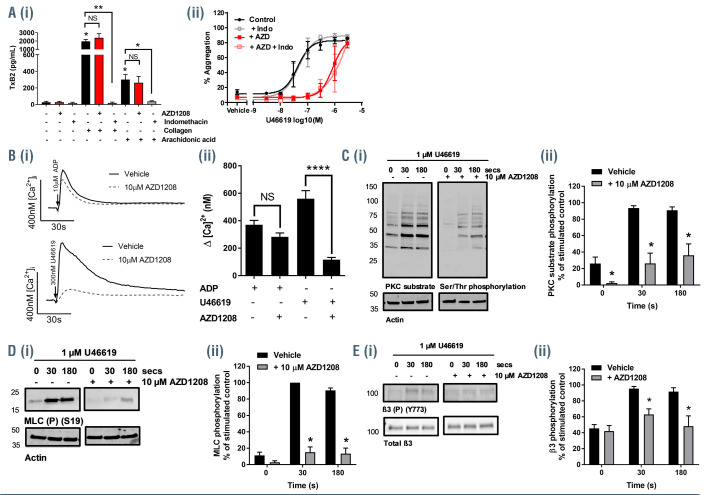Figure 5.
AZD1208 inhibits thromboxane receptor signaling. (A) Resting and stimulated human washed platelets were treated with 10 μM AZD1208 for 10 min and stimulated with (i) collagen (1 μg/mL) or arachidonic acid (1 mM) or (ii) U46619 (0-3 μM) in the presence and absence of indomethacin (10 μM). (i) TxB2 levels (EnzoLife Sciences ELISA) or (ii) aggregation were monitored after 5 min of shaking. (B) Mobilization of intracellular calcium was determined in FURA-2 AM loaded platelets following stimulation with U46619 (300 nM) or ADP (10 μM). (i) Representative traces and (ii) quantified data are shown, with data expressed as the change in [Ca2+] (nM). (C-E) Human platelets were pre-incubated with vehicle or AZD1208 (10 μM) for 10 min and stimulated with U46619 (1 μM) for 30 s or 3 min before lysis in SDS Laemmli sample buffer. (C) Protein kinase C (PKC) activity was determined by blotting these samples and using a phospho-site specific antibody (for the PKC substrate recognition sequence) that detects PKC substrate phosphorylation. (D) Myosin light chain (MLC) phosphorylation at Ser19 was determined using a phospho-specific antibody that recognizes the phosphorylated MLC. (E) Phosphorylation of the integrin β3 subunit at Y773 was determined using a phospho-specific antibody. Actin was used to confirm equal loading. (i) Representative blots and (ii) quantified data are shown. Levels of total phosphorylation were quantified and expressed as a percentage of the maximum phosphorylation observed in vehicle-treated, stimulated controls. Results are mean + standard error of mean for n≥3, *P≤0.05 in comparison to vehicle controls.

